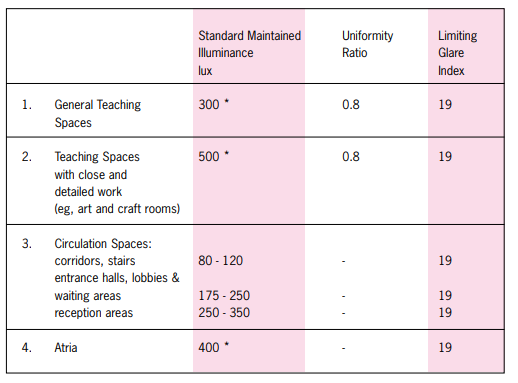A Guide to School Lighting Levels


Making sure that lighting levels in schools are exactly right is complex given the wide range of different areas and needs.
The aim is for a perfect balance between design and functionality that provides a comfortable and stimulating environment for pupils, teachers and other staff.
The CIBSE Code for Lighting is the comprehensive bible for all aspects of illumination – below is a brief guide on lighting levels. The code is a reference for lighting designers and planners, complementing aesthetic skills and knowledge.
Since 2002, the Committee for European Standardisation (CEN) has provided lighting recommendations, adopted by the British Standards Institution, with a range of British Standards (BS) specifying quantitative lighting requirements for many applications. CIBSE’s lighting guides reference these standards.
The CIBSE “Lighting Guide LG5: Lighting for education” is exhaustive and detailed on the lighting of all school spaces including teaching rooms, conference rooms and special-purpose rooms such as sports halls, art rooms and dance studios) as well as multi-purpose rooms and theatres.
LG5 provides detailed guidance on lighting equipment and positioning along with other key factors such as the decoration and finishes of rooms, sightlines, positioning of lighting controls and access doors.
The Government has used LB5 as reference for guidance in its Advice on standards for school premises
The guidance says that for school lighting to be suitable, attention needs to be paid to:
- achieving adequate light levels, including the lighting of teachers’ and pupils’ faces for good visual communication
- giving priority to daylight in all teaching spaces, circulation, staff offices and social areas
- providing adequate views to the outside or into the distance to ensure visual comfort and help avoid eye strain
- providing lighting controls that are easy to use
- providing means to control daylight and sunlight, to avoid glare, excessive internal illuminance and summertime overheating
- providing external lighting to ensure safe pedestrian movement after dark
- floodlighting outdoor sports areas
- providing emergency lighting in areas accessible after dark.
For reference, the lux is the international standard unit of illuminance and luminous emittance, According to Wikipedia, it measures luminous flux per unit area. It is equal to one lumen per square metre. In photometry, this is used as a measure of the intensity, as perceived by the human eye, of light that hits or passes through a surface.
From this, the code provides detailed advisory information on lighting levels. Here is a snapshot table of effective lighting levels across a wide range of settings:

The Health and Safety Executive has set a minimum level for any permanently occupied area of 200 lux.
CIBSE: https://www.cibse.org/knowledge/knowledge-items/detail?id=a0q20000008I7kGAAS